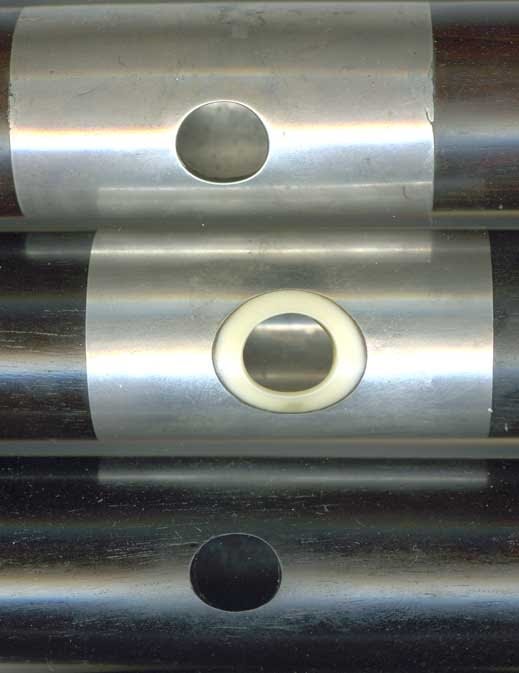In the more than ten years that I have been making pvc flutes, I used a simple circular embouchure hole of about 9.5 mm in diameter. My original idea was to keep the embouchure area rather small to compensate for the large cylindrical bore (20 mm dia.) of the pipe that I was using for the large bore flutes. The small blowing area forced the player to form a focused embouchure in order to play the flute.
Recently, I have been encouraged to offer a larger, more conventional oval-shaped embouchure, since most Irish flutes have some form of an oval or ellipsoidal-shaped embouchure hole. A larger embouchure hole allows more air to enter the flute and gives the flute greater possibilities and more power. Having successfully used this oval embouchure hole for over a year now, I am ready to recommend this larger oval embouchure for all skill levels. The smaller round embouchure is still available, and as of June, 2013 after playing through a group of my old personal flutes with the smaller round embouchure hole, I have decided to bring it back from the grave and speak more highly of it, although I realize that this may cause more ambiguity in the flute selection process. I will try to explain some of the differences on the page “Sorting Out the Options”. In general, I don’t think that you can go wrong with either of these embouchures. Although somewhat different, they both work well with my flutes, and either would be fine for the beginning student or the advanced performer.
The photo (thanks to Rob in London) below shows the oval embouchures of three Irish flutes from well-known makers. From top to bottom: Rudall Rose @ 10.8 x 12 mm, Wilkes @ 10 x 11.5 mm, and Doyle @ 9.5 x 11.5 mm. While the embouchures for my flutes will vary slightly, depending on the size of the flute and whether or not there is a lip plate (offering greater chimney depth), I intend to cut oval embouchures that are in the above range, with the embouchure of a low D flute with lip plate being around 9.5 mm x 11 mm. Keep in mind, however, that the above dimensions are about the outer shape of the embouchure hole, and that is only one of the variables in the design of an embouchure hole. Equally important are the chimney depth of the hole and to what degree the blowing edge, sidewalls, and backwall are cut. With all of these variables the possibilites for embouchure hole design are nearly endless.






